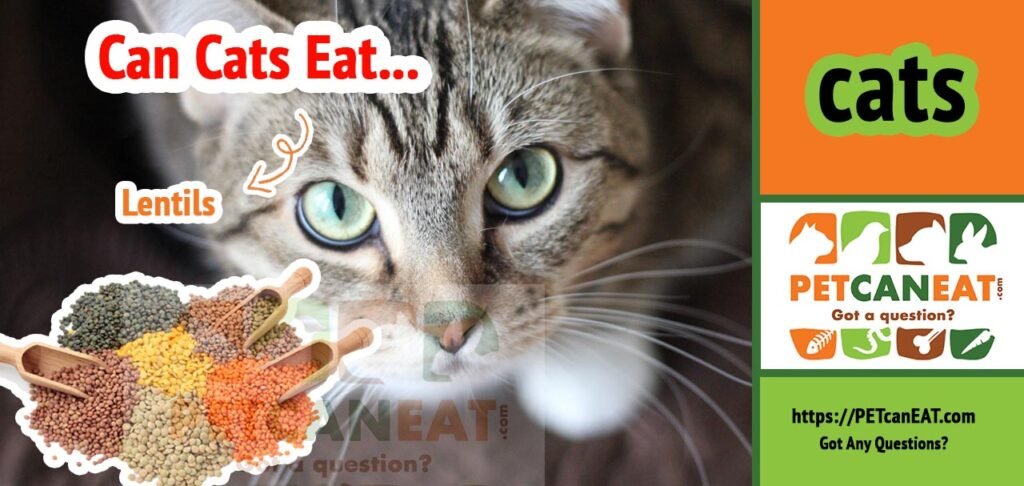Due to Cats’ bland taste buds, they will eat anything that looks or feels like food. This may include lentils and many other greens. So don’t be amazed when you spot your feline friend tasting the last bit of lentils you left on the kitchen countertop table. Herein lies the question, can cats eat lentils?

As a loving pet owner, you should always be wary of food that comes in contact with your cat. This is especially true if the food in question is not an animal product.
You will find that cats have different dietary needs than we do. Let’s find out if they can eat lentils?
Can cats eat lentils? What The is
Lentils are a particular type of grain that comes from the legume family. This plant is scientifically known as Lens culinaris.
At first glance, lentils may look like your ordinary beans. But these two grains are very different in appearance and diet. The difference between the regular beans and lentils is that lentils, as the name implies, are smaller and lens-shaped, whereas beans are not; they are kidney-shaped and relatively bigger.
Lentils also come in a variation of colors and sizes. There are at least 12 different lentil varieties, although not all are more readily available or widely used in cooking—the most common include.
Can cats eat lentils – The types
Brown lentils
Brown lentils have a hearty flavor and hold their shape well after cooking. They are perfect for stews and slow cooks.
- Black Beluga Lentils
Black Beluga lentils are small, black. They are commonly used as a base for hot salads. They are shiny and have a striking resemblance to caviar: hence their name.
Puy Lentils
Puy lentils are named after Le Puy in France, the region where they are mainly grown. These lentils are generally smaller than green lentils and have an intense, spicy flavor.
Green Lentils
As the name implies, green lentils are green. They are considered to be one of the most affordable options in the lentil family.
Yellow and red lentils
Although their colors are not precisely yellow and red (from yellow to orange), Yellow and red lentils have a sweet and nutty flavor. They are easier to cook and are ideal for making wood beans.
Can cats eat lentils? – The answer
According to archaeological, historical evidence, humans have been eating lentils for thousands of years. Understandably, these grains continue to be popular even in this modern times.
Many nutritionists consider lentils to be a superfood. The grains come packed with many nutrients that are very beneficial and healthy for humans.
Lentils are not only low in fat, but they are also high in fiber and protein. Lentils are also rich in essential nutrients, including folic acid, pantothenic acid, thiamin, vitamin B6, iron, phosphorus, and zinc.
So that brings us to the petcaneat question of the day, can cats eat lentils?
After seeing all the nutritional benefits of lentils, you probably guessed the answer! Yes, cats can eat lentils. But they probably shouldn’t.
Can cats eat lentils? Are they safe?
While your cat may not have any poisoning after eating a few servings of lentils, eating too many lentils may trigger a host of gastrointestinal problems, such as vomiting and diarrhea. In addition, lentils do not meet most of a cat’s dietary needs. If you must feed lentils to your kitten, do so only occasionally. Lentils should not replace your cat’s main diet. A feline-specific diet which the market is no short of, is still the recommended diet for your cat.
The most important thing is to feed your cat lentils in moderation and never regularly. This is the only way to avoid some common side effects of plant-based foods for cats.
Cat owners often wonder, are lentils safe for cats? Before we dive into the potential benefits and risks of lentils for cats, let’s take a brief look at what lentils are.
Nutrient datasheet
According to the USDA, one cup of cooked lentils (or about 100 grams) provides the following nutritional benefits: the nutritional content of lentils.
| Name | Amount | Unit |
| Water | 8.26 | g |
| Energy | 352 | kcal |
| Energy | 1470 | kJ |
| Protein | 24.6 | g |
| Total lipid (fat) | 1.06 | g |
| Ash | 2.71 | g |
| Carbohydrate, by difference | 63.4 | g |
| Fiber, total dietary | 10.7 | g |
| Sugars, total including NLEA | 2.03 | g |
| Sucrose | 1.47 | g |
| Fructose | 0.27 | g |
| Maltose | 0.3 | g |
| Starch | 49.9 | g |
| Calcium, Ca | 35 | mg |
| Iron, Fe | 6.51 | mg |
| Magnesium, Mg | 47 | mg |
| Phosphorus, P | 281 | mg |
| Potassium, K | 677 | mg |
| Sodium, Na | 6 | mg |
| Zinc, Zn | 3.27 | mg |
| Copper, Cu | 0.754 | mg |
| Manganese, Mn | 1.39 | mg |
| Selenium, Se | 0.1 | µg |
| Vitamin C, total ascorbic acid | 4.5 | mg |
| Thiamin | 0.873 | mg |
| Riboflavin | 0.211 | mg |
| Niacin | 2.6 | mg |
| Pantothenic acid | 2.14 | mg |
| Vitamin B-6 | 0.54 | mg |
| Folate, total | 479 | µg |
| Folate, food | 479 | µg |
| Folate, DFE | 479 | µg |
| Choline, total | 96.4 | mg |
| Vitamin A, RAE | 2 | µg |
| Carotene, beta | 23 | µg |
| Vitamin A, IU | 39 | IU |
| Vitamin E (alpha-tocopherol) | 0.49 | mg |
| Tocopherol, gamma | 4.23 | mg |
| Vitamin K (phylloquinone) | 5 | µg |
| Fatty acids, total saturated | 0.154 | g |
| SFA 14:0 | 0.003 | g |
| SFA 16:0 | 0.136 | g |
| SFA 18:0 | 0.015 | g |
| Fatty acids, total monounsaturated | 0.193 | g |
| MUFA 16:1 | 0.003 | g |
| MUFA 18:1 | 0.184 | g |
| MUFA 20:1 | 0.006 | g |
| Fatty acids, total polyunsaturated | 0.526 | g |
| PUFA 18:2 | 0.414 | g |
| PUFA 18:3 | 0.112 | g |
| Tryptophan | 0.221 | g |
| Threonine | 0.882 | g |
| Isoleucine | 1.06 | g |
| Leucine | 1.79 | g |
| Lysine | 1.72 | g |
| Methionine | 0.21 | g |
| Cystine | 0.322 | g |
| Phenylalanine | 1.22 | g |
| Tyrosine | 0.658 | g |
| Valine | 1.22 | g |
| Arginine | 1.9 | g |
| Histidine | 0.693 | g |
| Alanine | 1.03 | g |
| Aspartic acid | 2.72 | g |
| Glutamic acid | 3.82 | g |
| Glycine | 1 | g |
| Proline | 1.03 | g |
| Serine | 1.14 | g |
Based on the above nutritional profile, it is clear why lentils are considered a superfood. Note, however, that lentils are only a superfood in terms of their benefits to humans. For cats, lentils provide only minimal dietary benefits.
Potential benefits of lentils for cats
As we saw from the nutritional profile above, lentils are very high in protein. In fact, of all the vegetable foods available for human consumption, lentils contain the highest protein content. This also makes them a possible recommendation for cats.
packed with protein
A high protein diet is essential for all animals. Protein forms the building blocks of cells, tissues, organs, and muscles.
Protein is also known for its ability to suppress appetite. That’s because protein-rich foods produce a more extended period of satiety. Therefore, feeding your cat lentils is a great way to monitor your animal’s food to control its weight.
Lentils can be an excellent substitute for animal protein. However, this does not mean that the grain should completely replace a cat’s need for animal protein.
High-fiber content
In addition to protein, lentils are also rich in dietary fiber. Although cats can eat almost no fiber, a fiber-rich diet can still provide them with many benefits.
Most notably, fiber (especially insoluble fiber) aids in digestion by increasing the volume of the cat’s stool, thus allowing him to defecate more frequently. Therefore, supplementing a cat’s diet with lentils may help alleviate digestive problems such as constipation.
Fiber also works synergistically with protein to produce a more extended period of satiety. In addition, fiber-rich foods nourish the beneficial bacteria in the cat’s intestinal tract.
Other nutritional contents of Lentils
Lentils are rich in polyphenols, such as proanthocyanidins and flavanols. Polyphenols have powerful antioxidant properties that reduce the risk of various chronic diseases such as heart disease, feline arthritis, and certain cancers.
Other notable minerals in lentils beneficial to cats include vitamin B3, folic acid, iron, manganese, and phosphorus.
Considering the potential benefits of lentils for cats highlighted above, you may now be wondering, are lentils suitable for cats? Well, the following section may provide more insight into this.
Potential risks of lentils for cats
Despite their rich dietary profile, many of the minerals found in lentils may not be suitable for your cat. That’s because cats have varying nutritional needs than humans.
Not a cat’s cup of tea
While humans are omnivores meaning they can safely consume meat-based products and plant-based foods such as lentils, cats are dedicated carnivores.
Cats can get all their nutritional elements exclusively from animal protein. Well, this should not stop you from supplementing your cat’s diet with lentils. It just means that your feline friend will not benefit from the minerals in lentils as much as you will.
Fiber – too much of it
In addition, lentils are high in fiber. A small amount of fiber may help your cat’s digestion. Unfortunately, the fiber content in lentils may be a little too high for your cat’s stomach to handle. Large amounts of fiber may have a laxative effect, leading to diarrhea and related complications such as dehydration and abdominal pain.
Carbs – even cats don’t need them
Lentils also contain worrisome levels of carbohydrates. Just like fiber, carbohydrates are not an essential nutrient for cats. The cat’s body secretes small amounts of enzymes that break down carbohydrates, such as intestinal disaccharidase and pancreatic amylase. Therefore, a high-carbohydrate diet such as lentils may increase the risk of metabolic disorders (such as obesity and diabetes) in cats.
Inhibitor contents in lentils
Finally, lentils contain trypsin inhibitors and phytates. These compounds act as anti-nutritional factors. Trypsin inhibitors cause a decrease in your cat’s ability to digest protein, while phytates block the absorption of certain dietary elements.
The best way to prepare lentils and feed them to cats
As a cat owner considering feeding your kitten lentils, you may wonder, can cats eat raw lentils? Can cats eat cooked lentils?
Cats should only eat cooked lentils, not raw.
Nowadays, there are many ways to prepare lentils for human consumption. However, there is only one procedure when it comes to preparing lentils for cats.
How to cook lentils for cats
- First, it is recommended to soak the lentils overnight. This helps denature the anti-nutrients in these grains, such as phytates and trypsin inhibitors.
- After soaking, simmer the lentils over medium heat until they are tender. This will make it easier for the cat to digest the grains. However, you should take proper care to avoid overcooking the lentils, as you may end up destroying many of the essential vitamins and minerals in them.
- Most importantly, bring the grains to a boil in water. Do not add salt, spices, or seasonings. While salt and spices add excellent flavors for humans, they can be disastrous for cats.
- When your lentils are ready, you can offer them to your kitten as a stand-alone treat or mix them with other foods, such as rice.
Can cats eat lentil soup?
A little lentil soup is probably fine for your cat. But large amounts of lentil soup can cause diarrhea.
Does the type and portion of lentils matter?
Although lentils differ slightly in their dietary structure and content, they all tend to have the same safety profile.
So, can cats eat green lentils? What about red lentils? Can cats eat red lentils?
The answer to both questions is yes. Both red and green lentils contain a variety of minerals that your cat may benefit from. However, as with all types of lentils, you should only feed your kitten green or red lentils in moderation.
Can cats eat lentil sprouts?
You may also be pondering the question, can cats eat lentil sprouts?
Lentil sprouts are the sprouts of the lentil plant. Cats can eat cooked lentil sprouts but in small portions. It is not recommended to feed raw lentil sprouts to cats.
Can kittens eat lentils?
Kittens have a lower immune system and a more sensitive stomach compared to adult cats. Therefore, it may not be the best feeding idea to feed lentils to kittens. We recommend that you do not feed lentils for young kittens; wait for them to mature a bit more before introducing any human foods to them.
Can cats eat lentils? – The conclusion
Lentils are not immediately harmful to cats. These grains contain specific nutrients that cats can benefit from.
However, remember to feed your cat lentils only in moderation. Large amounts of lentils can cause severe gastrointestinal problems in your kitten, including vomiting and diarrhea. In addition, your cat may not benefit from lentils in the same way that humans do.
Fortunately, there are many healthier plant-based lentil alternatives you can consider, including carrots and blueberries.





